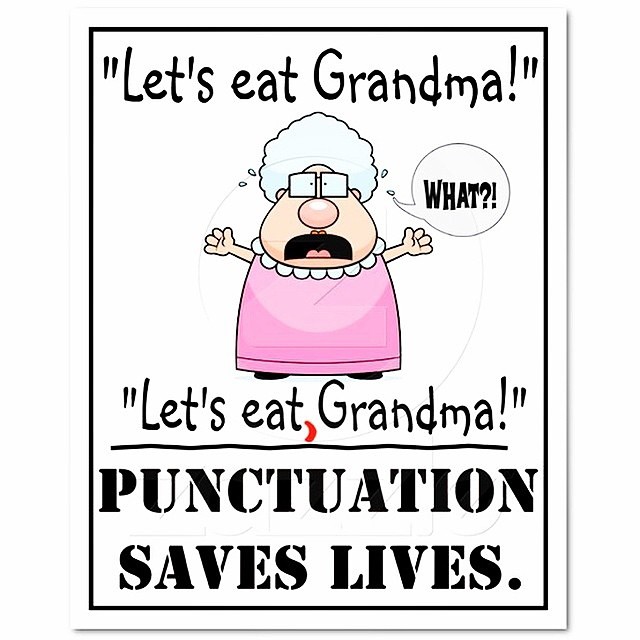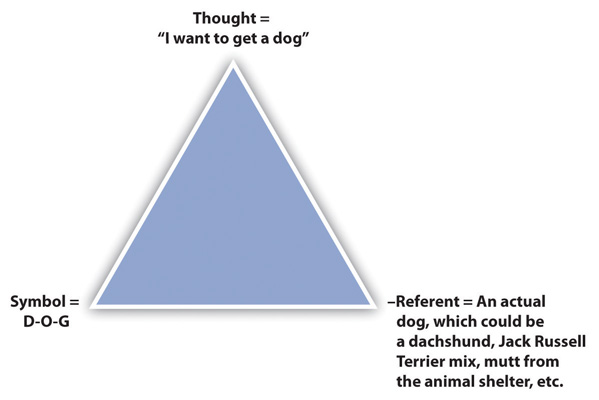3.1 The Nature of Language
Learning Objectives
- Explain how the triangle of meaning describes the symbolic nature of language.
- Discuss the function of the rules of language.
The relationship between language and meaning is not a straightforward one. One reason for this complicated relationship is the limitlessness of modern language systems like English (Crystal, 2005). Language is productive in the sense that there is an infinite number of utterances we can make by connecting existing words in new ways. In addition, there is no limit to a language’s vocabulary, as new words are coined daily. Of course, words aren’t the only things we need to communicate, and although verbal and nonverbal communication are closely related in terms of how we make meaning, we separate verbal and nonverbal communication in this text so that we can examine the unique qualities individually. This is a process essential in understanding how they work together to generate meaning.
You’ll recall that “generating meaning” was a central part of the definition of communication we learned earlier. We arrive at meaning through the interaction between our nervous and sensory systems and some stimulus outside of them. It is here, between what the communication models we discussed earlier labeled as encoding and decoding, that meaning is generated as sensory information is interpreted. The indirect and sometimes complicated relationship between language and meaning can lead to confusion, frustration, or maybe humor. We may even experience a little of all three when we stop to think about how there are some twenty-five definitions available to tell us the meaning of the word meaning (Crystal, 2005). Since language and symbols are the primary vehicles for our communication, it is important that we not take the components of our verbal communication for granted.
Language Is Symbolic
Our language system is primarily made up of symbols. A symbol is something that stands in for or represents something else. Symbols can be communicated verbally (speaking the word hello) or in writing (putting the letters H-E-L-L-O together). In any case, the symbols we use stand in for something else, like a physical object or an idea; they do not actually correspond to the thing being referenced in any direct way. Unlike hieroglyphics in ancient Egypt, which often did have a literal relationship between the written symbol and the object being referenced, the symbols used in modern languages look nothing like the object or idea to which they refer. For instance, someone along the way decided to call a computer a computer. It could have just as easily been named a pen but it was named a computer. Now, when I refer to my computer, we all know I am referring to the technological device I use to do work, homework, shop on Amazon, etc.
The triangle of meaning is a model of communication that indicates the relationship between a thought, symbol, and referent and highlights the indirect relationship between the symbol and referent (Richards & Ogden, 1923). As you can see in Figure 3.1 “Triangle of Meaning”, the thought is the concept or idea a person references. The symbol is the word that represents the thought, and the referent is the object or idea to which the symbol refers. This model is useful for us as communicators because when we are aware of the indirect relationship between symbols and referents, we are aware of how common misunderstandings occur.
Consider the following example: Max and Sam have been thinking about getting a new dog. So each of them is having a similar thought. They are each using the same symbol, the word dog, to communicate their thoughts. Their referents, however, are different. Max is thinking about a small dog like a dachshund, and Sam is thinking about an Australian shepherd. Since the word dog doesn’t refer to one specific object in our reality, it is possible for them to have the same thought, and use the same symbol, but end up in an awkward moment when they get to the shelter and fall in love with their respective referents only to find out the other person didn’t have the same thing in mind.
Being aware of this indirect relationship between symbol and referent, we can try to compensate for it by getting clarification. Some of what we learned in chapter 2 about perception checking, can be useful here. Sam might ask Max questions such as, “What kind of dog do you have in mind?” This question would allow Max to describe their referent, which would allow for a more shared understanding. If Max responds, “Well, I like short-haired dogs. And we need a dog that will work well in an apartment,” then there’s still quite a range of referents. Sam could ask questions for clarification, like “Sounds like you’re saying that a smaller dog might be better. Is that right?” Unfortunately, getting to a place of shared understanding can be difficult, even when we define our symbols and describe our referents.
Language is Learned
The relationship between the symbols that make up our language and their referents is arbitrary, which means they have no meaning until we assign that meaning. In order to effectively use a language system, we have to learn, over time, which symbols go with which referents since we can’t just tell by looking at the symbol. Like me, you probably learned what the word apple meant by looking at the letters A-P-P-L-E and a picture of an apple and having a teacher or caregiver help you sound out the letters until you said the whole word. Over time, we associated that combination of letters with the picture of the red delicious apple (or in my case a Gala apple because those are my favorite) and no longer had to sound each letter out. This is a deliberate process that may seem slow at the moment, but as we will see next, our ability to acquire language is actually quite astounding. We didn’t just learn individual words and their meanings, though; we also learned rules of grammar that help us put those words into meaningful sentences.
Language Rules
Semantic Rules
First, semantic rules refer to the meanings of words. They are rules that people have agreed on to give meaning to certain symbols and words. However, the meaning of a word can change based on the context in which it is used. For instance, the word fly by itself does not mean anything. It makes more sense if we put the word into a context by saying things like, “There is a fly on the wall;” “I will fly to Dallas tomorrow;” “That girl is so fly;” or “The fly on your pants is open!” We would not be able to communicate with others if we did not have semantic rules.
Definitions help us narrow the meaning of particular symbols, which also narrows a symbol’s possible referents. They also provide more words (symbols) for which we must determine a referent. If a concept is abstract and the words used to define it are also abstract, then a definition may be useless. Have you ever been caught in a verbal maze as you look up an unfamiliar word, only to find that the definition contains more unfamiliar words? Although this can be frustrating, definitions do serve a purpose.
However, using words is not as simple as using the dictionary definition of a word. Words have denotative and connotative meanings. Denotation refers to definitions that are accepted by the language group as a whole, or the dictionary definition of a word. For example, the denotation of the word cowboy is a man who takes care of cattle. Another denotation is a reckless and/or independent person (Dictonary.com). A more abstract word, like change, would be more difficult to understand due to the multiple denotations. Since both cowboy and change have multiple meanings, they are considered polysemic words. Monosemic words have only one use in a language, which makes their denotation a bit more straightforward.
Semantic misunderstandings may arise when people give different meanings to the same words or phrases. Connotation refers to definitions that are based on emotion – or experience-based associations people have with a word. To go back to our previous words, change can have positive or negative connotations depending on a person’s experiences. A person who just ended a long-term relationship may think of change as good or bad depending on what they thought about their former partner. Even monosemic words like handkerchief that only have one denotation can have multiple connotations. A handkerchief can conjure up thoughts of dainty Southern belles or disgusting snot-rags. A polysemic word like cowboy has many connotations, and philosophers of language have explored how connotations extend beyond one or two experiential or emotional meanings of a word to constitute cultural myths (Barthes, 1972). Cowboy, for example, connects to the frontier and the western history of the United States, which has mythologies associated with it that help shape the narrative of the nation. While people who grew up with cattle or have families that ranch may have a very specific connotation of the word cowboy based on personal experience, other people’s connotations may be more influenced by popular cultural symbolism like that seen in westerns.
Syntactic Rules
Second, syntactic rules govern how we help guide the words we use. Syntactic rules can refer to the use of grammar, structure, and punctuation to help effectively convey our ideas. For instance, when we want to know where someone is, we may say “Where are you” as opposed to “where you are.” Both of these statements convey a different meaning and create different interpretations. The same thing can happen when you don’t place a comma in the right place. The comma can make a big difference in how people understand a message.
A great example of how syntactic rules is the Star Wars character, Yoda, who often speaks with different rules. He has said, “Named must be your fear before banish it you can” and “The greatest teacher, failure is.” This example illustrates that syntactic rules can vary based on culture or background.

Pragmatic Rules
Third, pragmatic rules help us interpret messages by analyzing the interaction completely. We need to consider the words used, how they are stated, our relationship with the speaker, and the objectives of our communication. For instance, the words “I want to see you now” would mean different things if the speaker was your boss versus your romantic partner. One could be a positive connotation, and another might be a negative one. The same holds true for humor. If we know that the other person understands and appreciates sarcasm, we might be more likely to engage in that behavior and perceive it differently from someone who takes every word literally.
Most pragmatic rules are based on culture and experience. For instance, the term “Netflix and chill” has been used to indicate that two people will hook up. Imagine someone from a different country who did not know what this meant; they would be shocked if they thought they were going to watch Netflix with the other person and just relax. Another example would be “Want to have a drink?”, which usually infers an alcoholic beverage. Another way of saying this might be to say, “Would you like something to drink?” The second sentence does not imply that the drink has to contain alcohol.
It is common for people to text in capital letters when they are angry or excited. You would interpret the text differently if the text was not in capital letters. For instance, “I love you” might be perceived differently from “I LOVE YOU!!!” Thus, when communicating with others, you should also realize that pragmatic rules can impact the message.
Because language is symbolic, these rules help us to learn how to use language in a way that helps us to communicate with others. Unfortunately, we still experience many misunderstandings! The rest of this chapter will explore challenges we face as well as suggestions to improve your use of language.
Key Takeaways
- The triangle of meaning is a model of communication that indicates the relationship among a thought, symbol, and referent, and highlights the indirect relationship between the symbol and the referent. The model explains how for any given symbol there can be many different referents, which can lead to misunderstanding.
- Denotation refers to the agreed on or dictionary definition of a word. Connotation refers to definitions that are based on emotion- or experience-based associations people have with a word.
- The rules of language help make it learnable and usable. Although the rules limit some of the uses of language, they still allow for the possibility of creativity and play.
Exercises
- Apply the triangle of meaning to a recent message exchange you had in which differing referents led to misunderstanding. What could you have done to help prevent or correct the misunderstanding?
- Think of some words that have strong connotations for you. How does your connotation differ from the denotation? How might your connotation differ from another person’s?
References
Barthes, R., Mythologies (New York, NY: Hill and Wang, 1972).
Crystal, D., How Language Works: How Babies Babble, Words Change Meaning, and Languages Live or Die (Woodstock, NY: Overlook Press, 2005), 8–9.
de Saussure, F., Course in General Linguistics, trans. Wade Baskin (London: Fontana/Collins, 1974).
Derrida, J., Writing and Difference, trans. Alan Bass (London: Routledge, 1978).
Eco, U., A Theory of Semiotics (Bloomington, IN: Indiana University Press, 1976).
Hayakawa, S. I. and Alan R. Hayakawa, Language in Thought and Action, 5th ed. (San Diego, CA: Harcourt Brace, 1990), 87.
How Words Work. (2021, August 6). Retrieved August 9, 2021, from https://socialsci.libretexts.org/@go/page/115935
Leeds-Hurwitz, W., Semiotics and Communication: Signs, Codes, Cultures (Hillsdale, NJ: Lawrence Erlbaum Associates, 1993), 53.
Richards, I. A. and Charles K. Ogden, The Meaning of Meaning (London: Kegan, Paul, Trench, Tubner, 1923).



